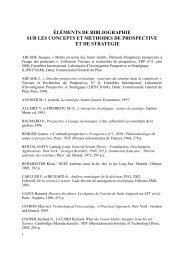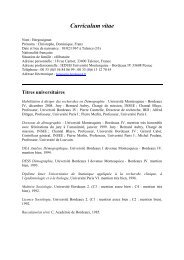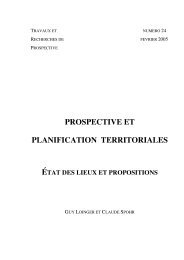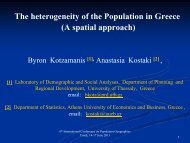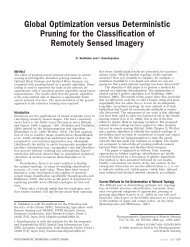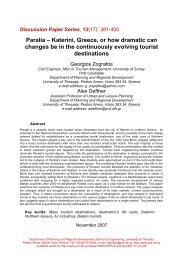<strong>International</strong> <strong>Journal</strong> <strong>of</strong> <strong>Architectural</strong> <strong>Research</strong>Pantoleon Skayanniswere still conservative, not saying much about the future major restructuring <strong>of</strong> the city. It is worthnoting that this plan faced a major contradiction, as also did much <strong>of</strong> the succeeding legislation <strong>of</strong>the governments thereafter. The contradiction is between planning and implementation. Thechances for the latter are frequently constrained by lack <strong>of</strong> funds, and <strong>of</strong>ten revealing theinadequacy <strong>of</strong> the state machinery to deal with the realization <strong>of</strong> complex plans. This does notonly apply for the plans per se but also for the various political decisions and announcements.Figure 5: The 1985 Regulatory (Mastr)Plan <strong>of</strong> Athens-Attiki(Source: Sarigiannis, 2012).It is indicative that though the metro <strong>of</strong> Athens was on the agenda, the PASOK governmentchanged the agenda announcing the construction <strong>of</strong> a tram, instead, as they were unsurewhether financing would be available for the metro. Possibly for the same reasons, the 1985regulatory master plan did not include detailed provisions for forthcoming projects such as roadsand trains. The physical planning <strong>of</strong> that period was more or less not comprehensive and to acertain extent arbitrary.In addition, this master plan similarly to the previous ones subdued economic planningunder the umbrella <strong>of</strong> physical planning. This reflected the temporal balance <strong>of</strong> a long lastingantagonism between two different approaches to spatial planning, one coming from the socioeconomicsphere and having a very general spatial dimension, and the other coming from thetraditional town planning stream having a more physical-technical dimension. This antagonismalso reflected the one between two ministries (Planning and Economy) as well as the lack <strong>of</strong>political will to give a solution.In the following years, thanks to the EEC/EU, the first financial possibilities were realizedby the Integrated Mediterranean Programs and later, and most importantly, by the fourconsecutive Community Support (and National Strategic Reference) Frameworks (CSF) 3 . In thenew context, the traditional 5-year economic development plans (general policy statements andlists incoherent not sufficiently interlinked projects), were gradually replaced by programs, dividedinto axes, measures, actions, etc., within time schedules and restrictions, budget lines regulatedby financing guidelines, regulations (Skayannis, 1994). Contrary to the previous 5-year economicdevelopment plans they had specific spatial references, thus coming closer to physical planning.The question <strong>of</strong> planning adaptation was also one <strong>of</strong> paradigm shift in planning, to a mergedplanning exercise whereby ‘economists’ and ‘architects’ would have to collaborate. This however,was not followed by an equally drastic change in the comprehension <strong>of</strong> modus operandi by the3 The CFS periods have been 1986–1993, 1994–1999, 2000–2006 and 2007-2013 (NSRF).Archnet-IJAR, Volume 7 - Issue 2 - July 2013 - (192-205) – Selected Papers196Copyright © 2013 Archnet-IJAR, <strong>International</strong> <strong>Journal</strong> <strong>of</strong> <strong>Architectural</strong> <strong>Research</strong>
<strong>International</strong> <strong>Journal</strong> <strong>of</strong> <strong>Architectural</strong> <strong>Research</strong>Pantoleon Skayannisadministration. So the ministry <strong>of</strong> Planning and the ministry <strong>of</strong> Economics remained separate andcompeting with each other, producing a chaotic situation regarding the priorities and thephilosophy.In addition to the above, two major developments characterized the eighties and the earlynineties: on the one hand, the Greek construction capital that had been very active in the Arabcountries <strong>of</strong> North Africa and the Middle East due to a variety <strong>of</strong> reasons (see Koutsoyannis,1984) was “returning” and seeking for investment opportunities within the country and in theBalkans that were just undergoing the first stages <strong>of</strong> their transformation from centrally planned t<strong>of</strong>ree economies. On the other hand, the prospect <strong>of</strong> the 2004 Olympic Games and theconstruction projects foreseen in the CSFs provided such an opportunity.Thus, a series <strong>of</strong> expectations for new projects started. However, these were planned andmaterialized, due to the special circumstances, over and above existing planning (in the sense <strong>of</strong>the master plan <strong>of</strong> the city). Special laws, such as Law 2730/1999 “Planning, IntegratedDevelopment and Materialization <strong>of</strong> the Olympic Works and other provisions”, were passed inorder to accelerate and legitimize pre-decided projects which did not exist in the master plan <strong>of</strong>the city.This “<strong>of</strong>ficial” by-passing <strong>of</strong> the law (<strong>of</strong> the existing regulatory master plan) was coupled bythe traditional common practice <strong>of</strong> arbitrary/unauthorized construction <strong>of</strong> housing (by and large <strong>of</strong>building on own property without permission, more rarely on public property, and very commonlyby provocatively violating planning regulations). It has to be mentioned that it was not merely thelower income classes that sought refuge to such a practice due to the higher expenses <strong>of</strong> legalconstruction, but the upper classes as well including- allegedly - high rank politicians, evenministers.This top-down and bottom-up by-passing and overlooking <strong>of</strong> pre-existing planninglegislation was left to survive due to the fact that construction had been one <strong>of</strong> the majorlocomotives <strong>of</strong> the Greek economy, able to speed up or slow down the pace <strong>of</strong> the economy(Skayannis, 1990). This was coupled by a planning governance that on the one hand wouldcollect the opinions <strong>of</strong> formal stakeholders but on the other would disregard the opinions <strong>of</strong>ordinary citizens and their organizations, in essence a political choice <strong>of</strong> non-participatoryplanning <strong>of</strong> any sort that obviously faced the problem <strong>of</strong> applicability.In this sense, the major planning achievements <strong>of</strong> the Olympic Games in Athens (parts <strong>of</strong>the “Olympic” program, or triggered, or accelerated by it) were the construction <strong>of</strong> a series <strong>of</strong>transport projects (Athens <strong>International</strong> Airport, Ring Road <strong>of</strong> Athens, two new Athens metrolines, the tram lines, improvement <strong>of</strong> some parts <strong>of</strong> the road network), the construction <strong>of</strong> athleticinstallations including the Olympic Village and the press center, and other minor projects. Most <strong>of</strong>these were not included in the existing master planning <strong>of</strong> the city or <strong>of</strong> the wider area and weredecided and imposed top-down over and above any different opinions <strong>of</strong> the residents. In certaincases, some court decisions accepted the cases against the state, such as the case <strong>of</strong> theperipheral road <strong>of</strong> mount Hymettus (part <strong>of</strong> the Athens Ring Road) that was raised by theAmerican College in Athens, and the state had to modify the plans. In other cases the localcommunities managed to negotiate for free spaces with the contractors thus increasing theprestige <strong>of</strong> certain mayors. Yet, at the field <strong>of</strong> environmental concerns, this sort <strong>of</strong> fast trackplanning did not leave much space for effective public consultation. Skayannis and Kaparos(2010) note that though there is a legal provision for inspection <strong>of</strong> the environmental assessmentstudies for the big projects, the time provided is limited, the volume <strong>of</strong> the studies very big, andthe knowledge required very specialized. Therefore the objective conditions are not that favorablefor raising objections from the part <strong>of</strong> interested parties let alone the chance for a substantialdebate that ends up being carried out through the media and frequently becomes a caricature.FROM THE OLYMPIC GAMES TO THE CURRENT CRISISDuring the post-Olympic Games period (2004-2010) Athens did not take full advantage <strong>of</strong> theOlympic projects and what is more <strong>of</strong> the Olympic experience. The new government <strong>of</strong> the NewArchnet-IJAR, Volume 7 - Issue 2 - July 2013 - (192-205) – Selected Papers197Copyright © 2013 Archnet-IJAR, <strong>International</strong> <strong>Journal</strong> <strong>of</strong> <strong>Architectural</strong> <strong>Research</strong>





